Kensington College Research Project: Managing the Generation Gap
VerifiedAdded on 2023/01/12
|24
|5695
|96
Project
AI Summary
This research project investigates the impact of the generation gap on organizational performance, using River Island as a case study. It explores factors that increase the gap, determines its impact on performance, and identifies strategies to mitigate negative consequences. The project includes a literature review covering relevant factors, impacts, and solutions, followed by a detailed methodology section outlining the research approach, sampling methods, and data analysis techniques. Data collection methods and ethical considerations are also addressed. The findings are presented in an organized manner, including data analysis, presentation, and discussion, leading to conclusions and recommendations for managing the generation gap effectively. A personal reflective statement is also included to evaluate the research methods used and suggest areas for further research.
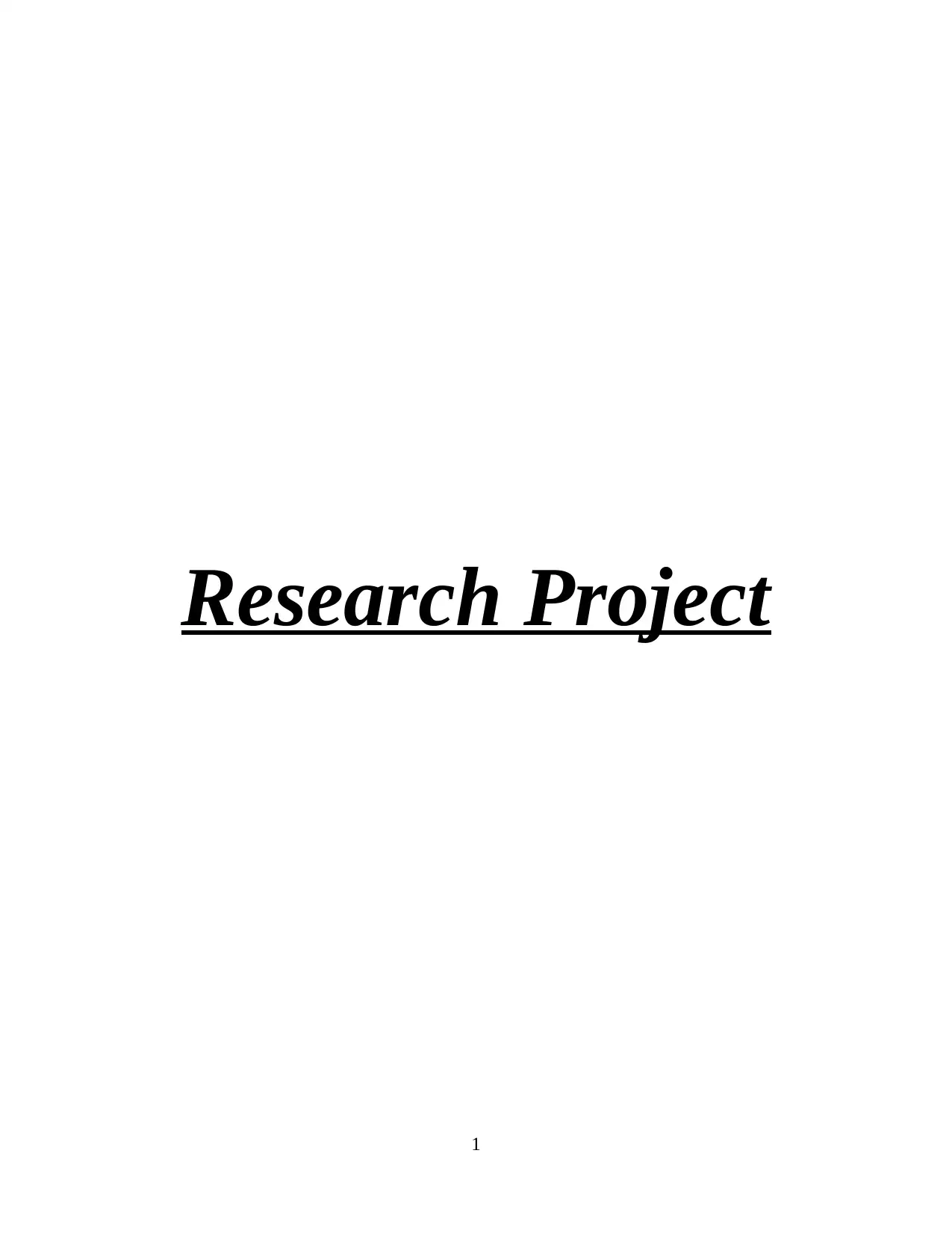
Research Project
1
1
Paraphrase This Document
Need a fresh take? Get an instant paraphrase of this document with our AI Paraphraser
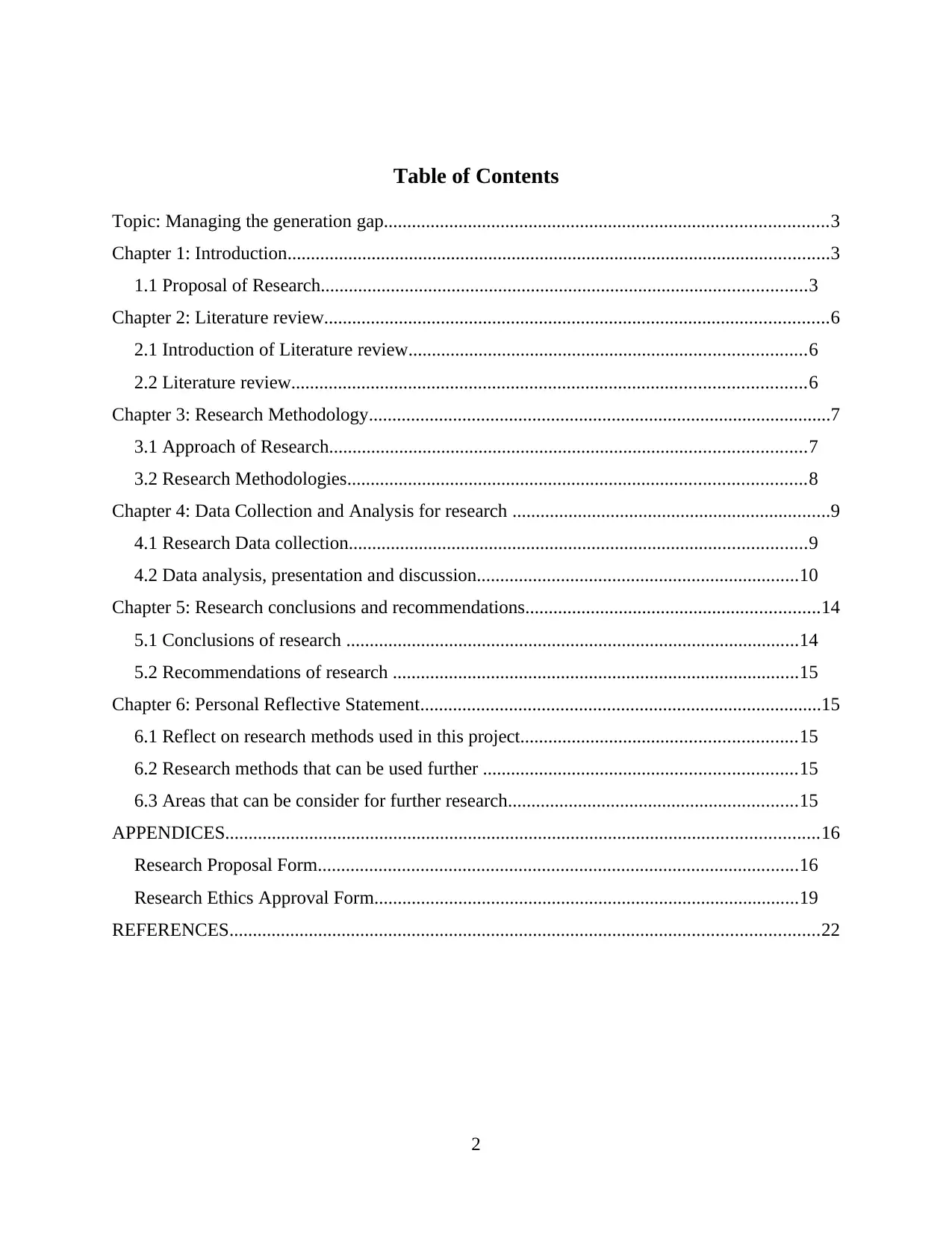
Table of Contents
Topic: Managing the generation gap...............................................................................................3
Chapter 1: Introduction....................................................................................................................3
1.1 Proposal of Research........................................................................................................3
Chapter 2: Literature review............................................................................................................6
2.1 Introduction of Literature review.....................................................................................6
2.2 Literature review..............................................................................................................6
Chapter 3: Research Methodology...................................................................................................7
3.1 Approach of Research......................................................................................................7
3.2 Research Methodologies..................................................................................................8
Chapter 4: Data Collection and Analysis for research ....................................................................9
4.1 Research Data collection..................................................................................................9
4.2 Data analysis, presentation and discussion.....................................................................10
Chapter 5: Research conclusions and recommendations...............................................................14
5.1 Conclusions of research .................................................................................................14
5.2 Recommendations of research .......................................................................................15
Chapter 6: Personal Reflective Statement......................................................................................15
6.1 Reflect on research methods used in this project...........................................................15
6.2 Research methods that can be used further ...................................................................15
6.3 Areas that can be consider for further research..............................................................15
APPENDICES...............................................................................................................................16
Research Proposal Form.......................................................................................................16
Research Ethics Approval Form...........................................................................................19
REFERENCES..............................................................................................................................22
2
Topic: Managing the generation gap...............................................................................................3
Chapter 1: Introduction....................................................................................................................3
1.1 Proposal of Research........................................................................................................3
Chapter 2: Literature review............................................................................................................6
2.1 Introduction of Literature review.....................................................................................6
2.2 Literature review..............................................................................................................6
Chapter 3: Research Methodology...................................................................................................7
3.1 Approach of Research......................................................................................................7
3.2 Research Methodologies..................................................................................................8
Chapter 4: Data Collection and Analysis for research ....................................................................9
4.1 Research Data collection..................................................................................................9
4.2 Data analysis, presentation and discussion.....................................................................10
Chapter 5: Research conclusions and recommendations...............................................................14
5.1 Conclusions of research .................................................................................................14
5.2 Recommendations of research .......................................................................................15
Chapter 6: Personal Reflective Statement......................................................................................15
6.1 Reflect on research methods used in this project...........................................................15
6.2 Research methods that can be used further ...................................................................15
6.3 Areas that can be consider for further research..............................................................15
APPENDICES...............................................................................................................................16
Research Proposal Form.......................................................................................................16
Research Ethics Approval Form...........................................................................................19
REFERENCES..............................................................................................................................22
2
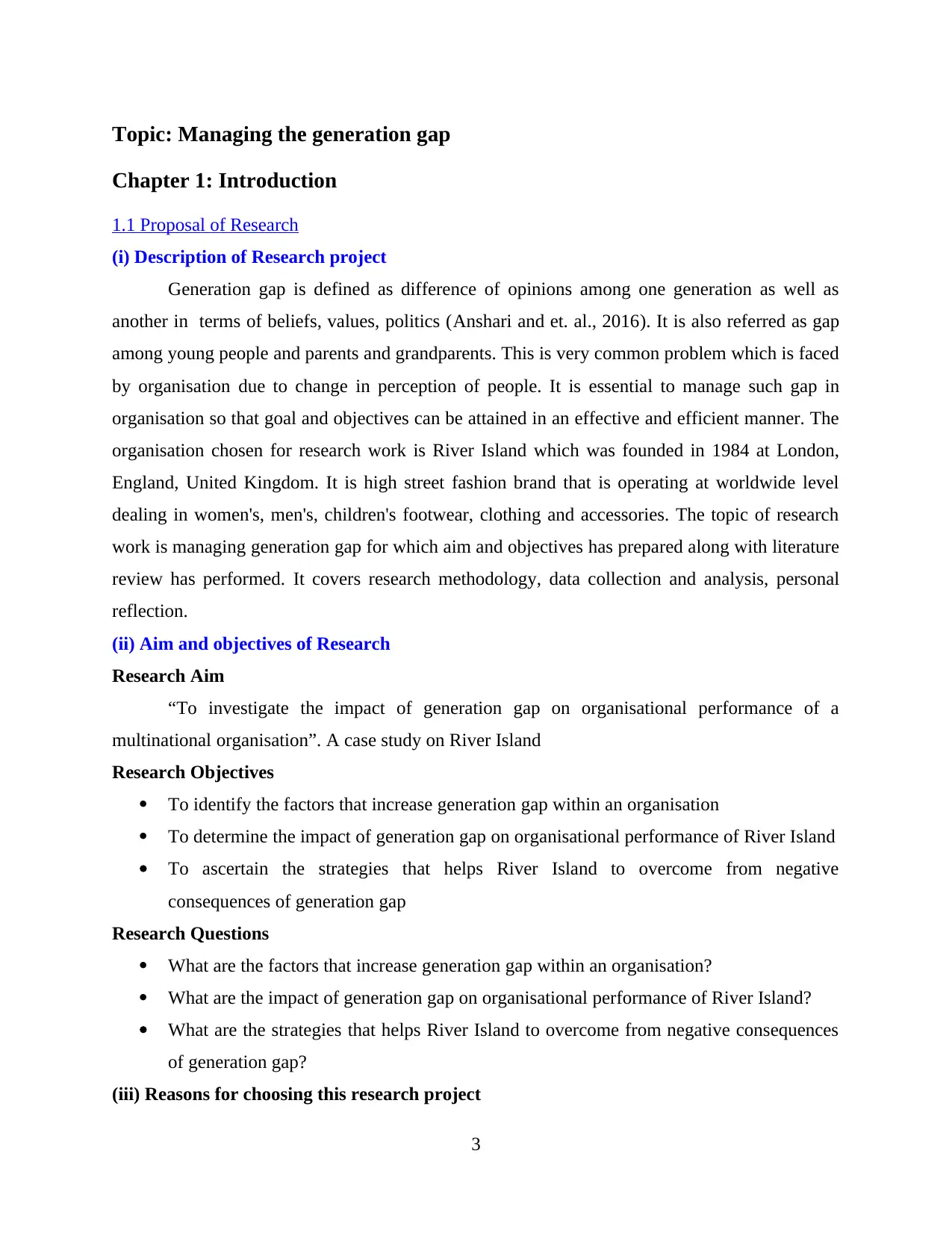
Topic: Managing the generation gap
Chapter 1: Introduction
1.1 Proposal of Research
(i) Description of Research project
Generation gap is defined as difference of opinions among one generation as well as
another in terms of beliefs, values, politics (Anshari and et. al., 2016). It is also referred as gap
among young people and parents and grandparents. This is very common problem which is faced
by organisation due to change in perception of people. It is essential to manage such gap in
organisation so that goal and objectives can be attained in an effective and efficient manner. The
organisation chosen for research work is River Island which was founded in 1984 at London,
England, United Kingdom. It is high street fashion brand that is operating at worldwide level
dealing in women's, men's, children's footwear, clothing and accessories. The topic of research
work is managing generation gap for which aim and objectives has prepared along with literature
review has performed. It covers research methodology, data collection and analysis, personal
reflection.
(ii) Aim and objectives of Research
Research Aim
“To investigate the impact of generation gap on organisational performance of a
multinational organisation”. A case study on River Island
Research Objectives
To identify the factors that increase generation gap within an organisation
To determine the impact of generation gap on organisational performance of River Island
To ascertain the strategies that helps River Island to overcome from negative
consequences of generation gap
Research Questions
What are the factors that increase generation gap within an organisation?
What are the impact of generation gap on organisational performance of River Island?
What are the strategies that helps River Island to overcome from negative consequences
of generation gap?
(iii) Reasons for choosing this research project
3
Chapter 1: Introduction
1.1 Proposal of Research
(i) Description of Research project
Generation gap is defined as difference of opinions among one generation as well as
another in terms of beliefs, values, politics (Anshari and et. al., 2016). It is also referred as gap
among young people and parents and grandparents. This is very common problem which is faced
by organisation due to change in perception of people. It is essential to manage such gap in
organisation so that goal and objectives can be attained in an effective and efficient manner. The
organisation chosen for research work is River Island which was founded in 1984 at London,
England, United Kingdom. It is high street fashion brand that is operating at worldwide level
dealing in women's, men's, children's footwear, clothing and accessories. The topic of research
work is managing generation gap for which aim and objectives has prepared along with literature
review has performed. It covers research methodology, data collection and analysis, personal
reflection.
(ii) Aim and objectives of Research
Research Aim
“To investigate the impact of generation gap on organisational performance of a
multinational organisation”. A case study on River Island
Research Objectives
To identify the factors that increase generation gap within an organisation
To determine the impact of generation gap on organisational performance of River Island
To ascertain the strategies that helps River Island to overcome from negative
consequences of generation gap
Research Questions
What are the factors that increase generation gap within an organisation?
What are the impact of generation gap on organisational performance of River Island?
What are the strategies that helps River Island to overcome from negative consequences
of generation gap?
(iii) Reasons for choosing this research project
3
⊘ This is a preview!⊘
Do you want full access?
Subscribe today to unlock all pages.

Trusted by 1+ million students worldwide
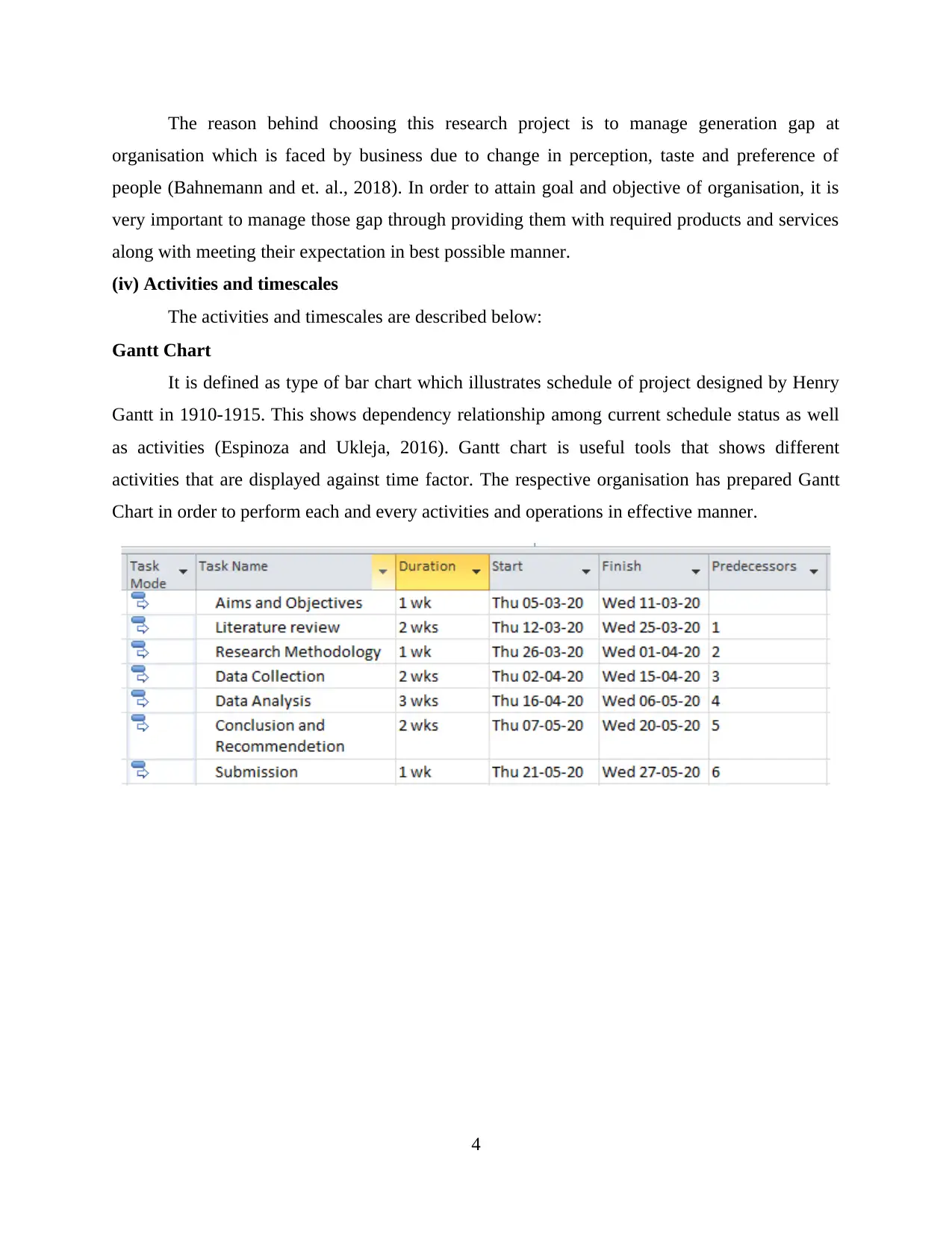
The reason behind choosing this research project is to manage generation gap at
organisation which is faced by business due to change in perception, taste and preference of
people (Bahnemann and et. al., 2018). In order to attain goal and objective of organisation, it is
very important to manage those gap through providing them with required products and services
along with meeting their expectation in best possible manner.
(iv) Activities and timescales
The activities and timescales are described below:
Gantt Chart
It is defined as type of bar chart which illustrates schedule of project designed by Henry
Gantt in 1910-1915. This shows dependency relationship among current schedule status as well
as activities (Espinoza and Ukleja, 2016). Gantt chart is useful tools that shows different
activities that are displayed against time factor. The respective organisation has prepared Gantt
Chart in order to perform each and every activities and operations in effective manner.
4
organisation which is faced by business due to change in perception, taste and preference of
people (Bahnemann and et. al., 2018). In order to attain goal and objective of organisation, it is
very important to manage those gap through providing them with required products and services
along with meeting their expectation in best possible manner.
(iv) Activities and timescales
The activities and timescales are described below:
Gantt Chart
It is defined as type of bar chart which illustrates schedule of project designed by Henry
Gantt in 1910-1915. This shows dependency relationship among current schedule status as well
as activities (Espinoza and Ukleja, 2016). Gantt chart is useful tools that shows different
activities that are displayed against time factor. The respective organisation has prepared Gantt
Chart in order to perform each and every activities and operations in effective manner.
4
Paraphrase This Document
Need a fresh take? Get an instant paraphrase of this document with our AI Paraphraser
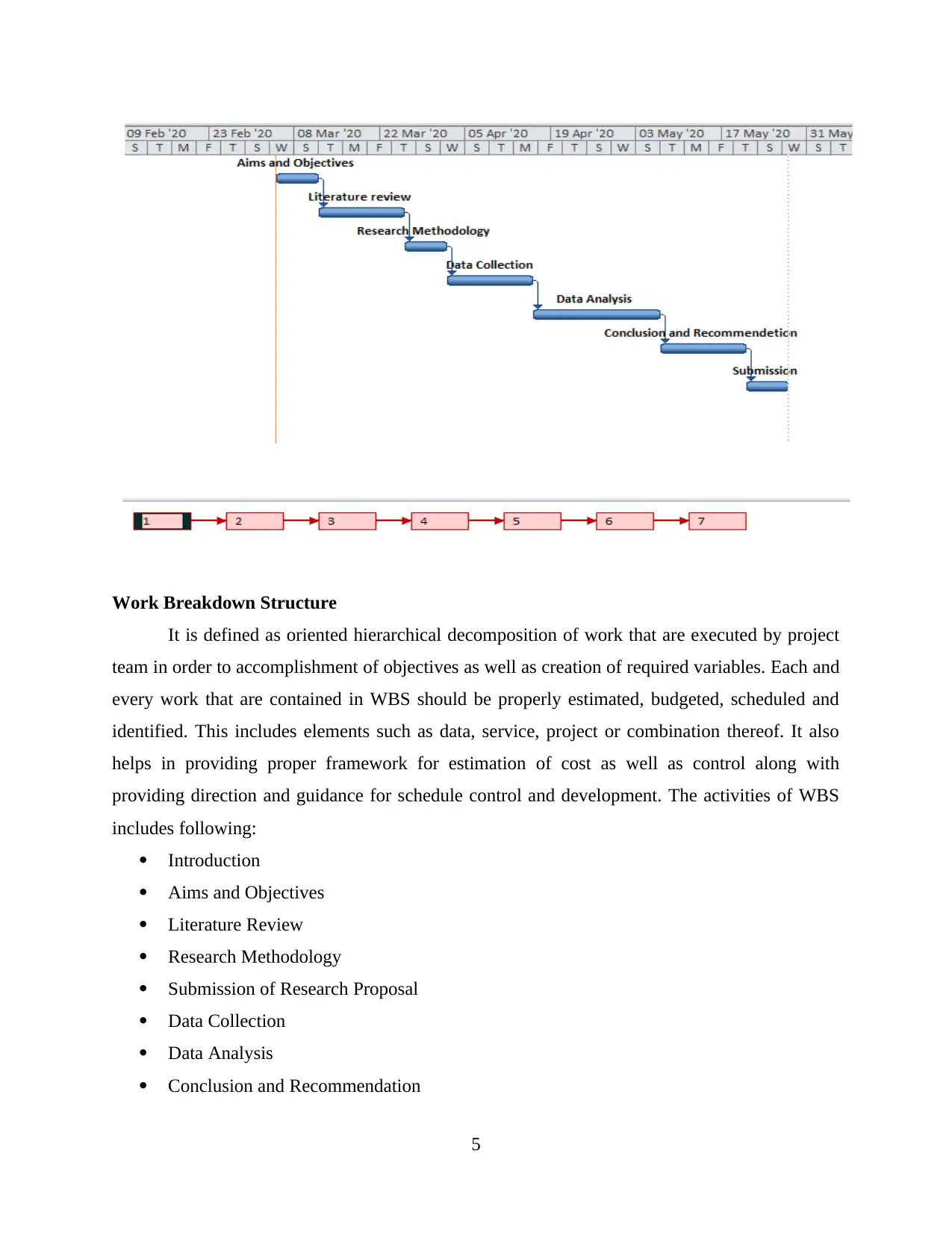
Work Breakdown Structure
It is defined as oriented hierarchical decomposition of work that are executed by project
team in order to accomplishment of objectives as well as creation of required variables. Each and
every work that are contained in WBS should be properly estimated, budgeted, scheduled and
identified. This includes elements such as data, service, project or combination thereof. It also
helps in providing proper framework for estimation of cost as well as control along with
providing direction and guidance for schedule control and development. The activities of WBS
includes following:
Introduction
Aims and Objectives
Literature Review
Research Methodology
Submission of Research Proposal
Data Collection
Data Analysis
Conclusion and Recommendation
5
It is defined as oriented hierarchical decomposition of work that are executed by project
team in order to accomplishment of objectives as well as creation of required variables. Each and
every work that are contained in WBS should be properly estimated, budgeted, scheduled and
identified. This includes elements such as data, service, project or combination thereof. It also
helps in providing proper framework for estimation of cost as well as control along with
providing direction and guidance for schedule control and development. The activities of WBS
includes following:
Introduction
Aims and Objectives
Literature Review
Research Methodology
Submission of Research Proposal
Data Collection
Data Analysis
Conclusion and Recommendation
5
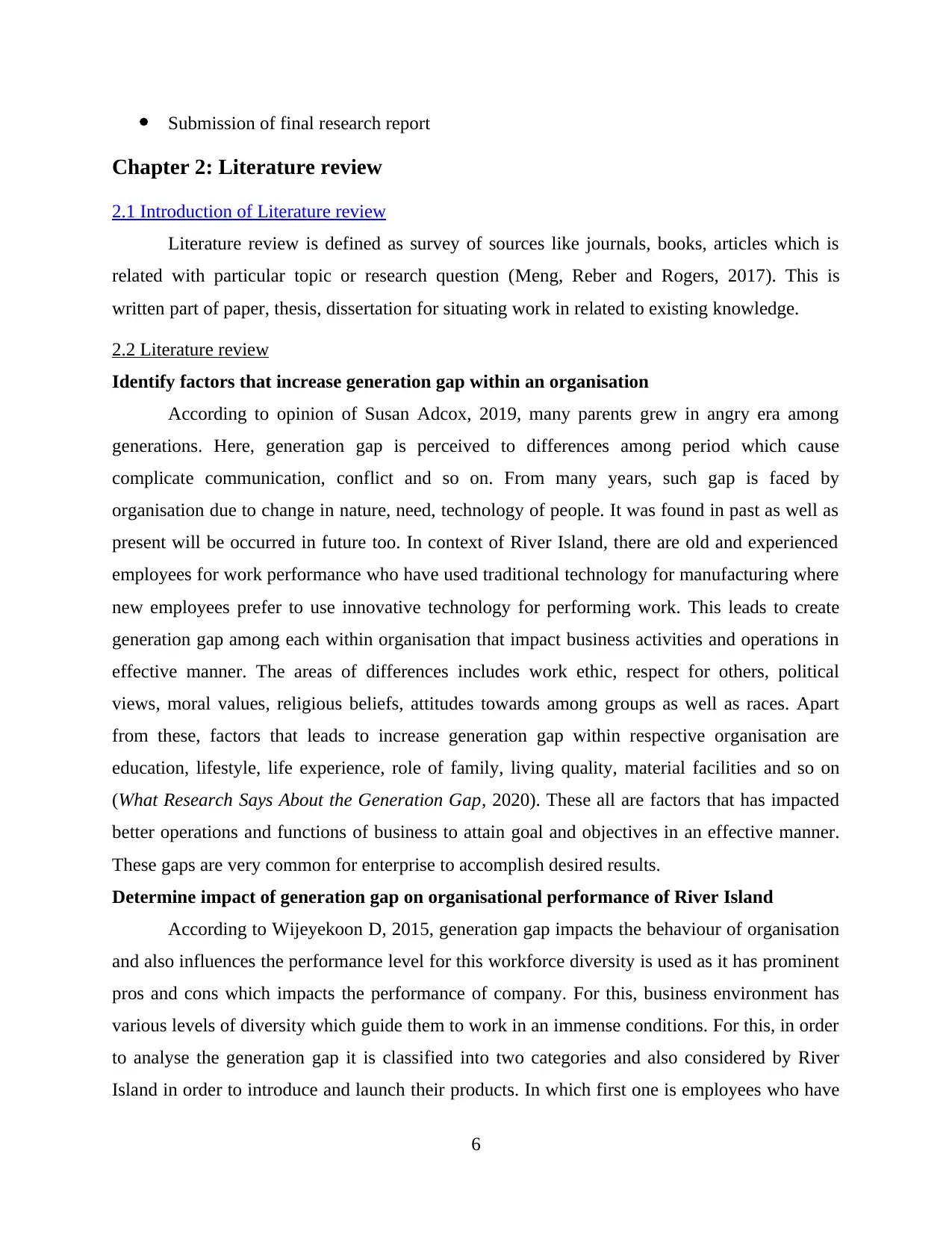
Submission of final research report
Chapter 2: Literature review
2.1 Introduction of Literature review
Literature review is defined as survey of sources like journals, books, articles which is
related with particular topic or research question (Meng, Reber and Rogers, 2017). This is
written part of paper, thesis, dissertation for situating work in related to existing knowledge.
2.2 Literature review
Identify factors that increase generation gap within an organisation
According to opinion of Susan Adcox, 2019, many parents grew in angry era among
generations. Here, generation gap is perceived to differences among period which cause
complicate communication, conflict and so on. From many years, such gap is faced by
organisation due to change in nature, need, technology of people. It was found in past as well as
present will be occurred in future too. In context of River Island, there are old and experienced
employees for work performance who have used traditional technology for manufacturing where
new employees prefer to use innovative technology for performing work. This leads to create
generation gap among each within organisation that impact business activities and operations in
effective manner. The areas of differences includes work ethic, respect for others, political
views, moral values, religious beliefs, attitudes towards among groups as well as races. Apart
from these, factors that leads to increase generation gap within respective organisation are
education, lifestyle, life experience, role of family, living quality, material facilities and so on
(What Research Says About the Generation Gap, 2020). These all are factors that has impacted
better operations and functions of business to attain goal and objectives in an effective manner.
These gaps are very common for enterprise to accomplish desired results.
Determine impact of generation gap on organisational performance of River Island
According to Wijeyekoon D, 2015, generation gap impacts the behaviour of organisation
and also influences the performance level for this workforce diversity is used as it has prominent
pros and cons which impacts the performance of company. For this, business environment has
various levels of diversity which guide them to work in an immense conditions. For this, in order
to analyse the generation gap it is classified into two categories and also considered by River
Island in order to introduce and launch their products. In which first one is employees who have
6
Chapter 2: Literature review
2.1 Introduction of Literature review
Literature review is defined as survey of sources like journals, books, articles which is
related with particular topic or research question (Meng, Reber and Rogers, 2017). This is
written part of paper, thesis, dissertation for situating work in related to existing knowledge.
2.2 Literature review
Identify factors that increase generation gap within an organisation
According to opinion of Susan Adcox, 2019, many parents grew in angry era among
generations. Here, generation gap is perceived to differences among period which cause
complicate communication, conflict and so on. From many years, such gap is faced by
organisation due to change in nature, need, technology of people. It was found in past as well as
present will be occurred in future too. In context of River Island, there are old and experienced
employees for work performance who have used traditional technology for manufacturing where
new employees prefer to use innovative technology for performing work. This leads to create
generation gap among each within organisation that impact business activities and operations in
effective manner. The areas of differences includes work ethic, respect for others, political
views, moral values, religious beliefs, attitudes towards among groups as well as races. Apart
from these, factors that leads to increase generation gap within respective organisation are
education, lifestyle, life experience, role of family, living quality, material facilities and so on
(What Research Says About the Generation Gap, 2020). These all are factors that has impacted
better operations and functions of business to attain goal and objectives in an effective manner.
These gaps are very common for enterprise to accomplish desired results.
Determine impact of generation gap on organisational performance of River Island
According to Wijeyekoon D, 2015, generation gap impacts the behaviour of organisation
and also influences the performance level for this workforce diversity is used as it has prominent
pros and cons which impacts the performance of company. For this, business environment has
various levels of diversity which guide them to work in an immense conditions. For this, in order
to analyse the generation gap it is classified into two categories and also considered by River
Island in order to introduce and launch their products. In which first one is employees who have
6
⊘ This is a preview!⊘
Do you want full access?
Subscribe today to unlock all pages.

Trusted by 1+ million students worldwide
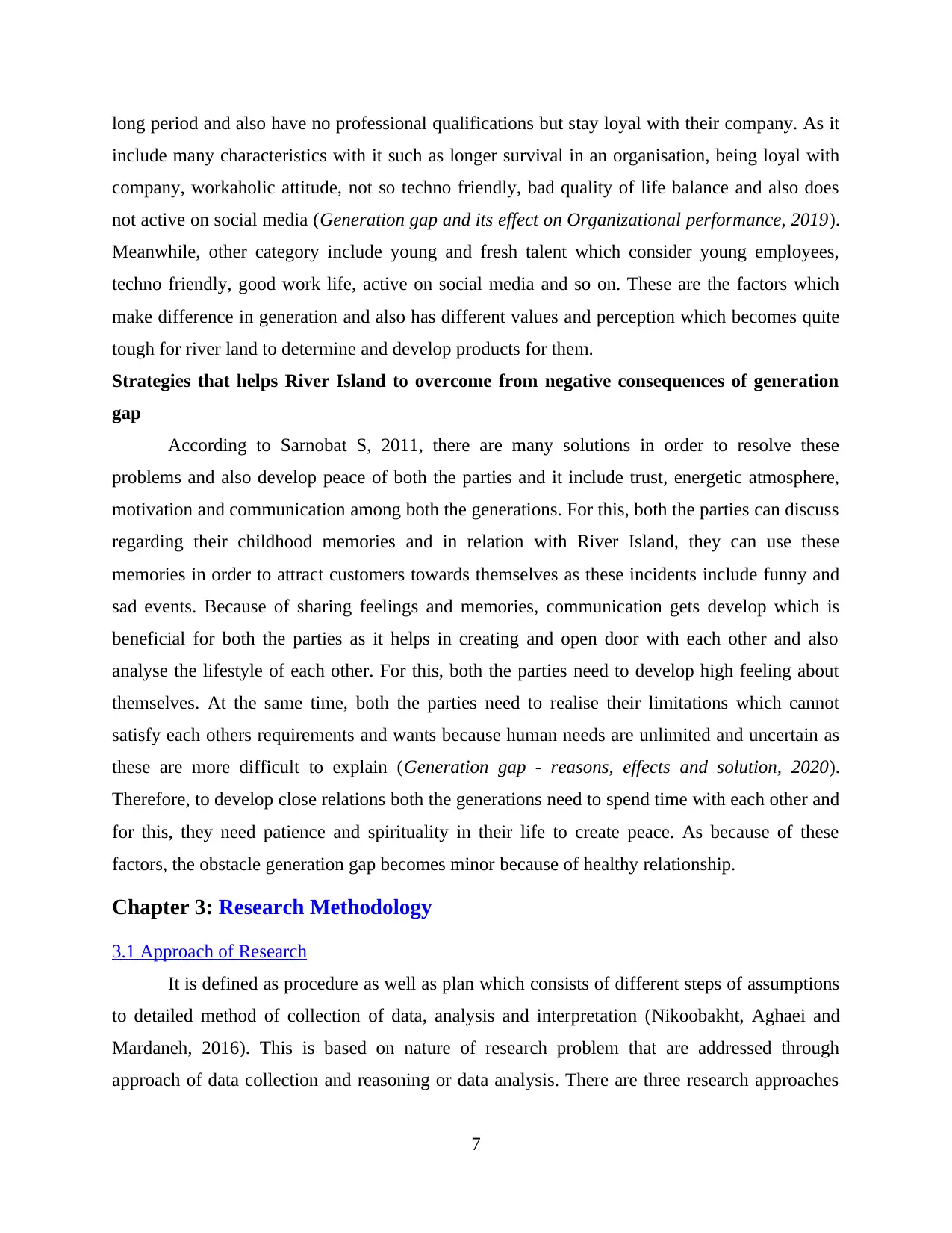
long period and also have no professional qualifications but stay loyal with their company. As it
include many characteristics with it such as longer survival in an organisation, being loyal with
company, workaholic attitude, not so techno friendly, bad quality of life balance and also does
not active on social media (Generation gap and its effect on Organizational performance, 2019).
Meanwhile, other category include young and fresh talent which consider young employees,
techno friendly, good work life, active on social media and so on. These are the factors which
make difference in generation and also has different values and perception which becomes quite
tough for river land to determine and develop products for them.
Strategies that helps River Island to overcome from negative consequences of generation
gap
According to Sarnobat S, 2011, there are many solutions in order to resolve these
problems and also develop peace of both the parties and it include trust, energetic atmosphere,
motivation and communication among both the generations. For this, both the parties can discuss
regarding their childhood memories and in relation with River Island, they can use these
memories in order to attract customers towards themselves as these incidents include funny and
sad events. Because of sharing feelings and memories, communication gets develop which is
beneficial for both the parties as it helps in creating and open door with each other and also
analyse the lifestyle of each other. For this, both the parties need to develop high feeling about
themselves. At the same time, both the parties need to realise their limitations which cannot
satisfy each others requirements and wants because human needs are unlimited and uncertain as
these are more difficult to explain (Generation gap - reasons, effects and solution, 2020).
Therefore, to develop close relations both the generations need to spend time with each other and
for this, they need patience and spirituality in their life to create peace. As because of these
factors, the obstacle generation gap becomes minor because of healthy relationship.
Chapter 3: Research Methodology
3.1 Approach of Research
It is defined as procedure as well as plan which consists of different steps of assumptions
to detailed method of collection of data, analysis and interpretation (Nikoobakht, Aghaei and
Mardaneh, 2016). This is based on nature of research problem that are addressed through
approach of data collection and reasoning or data analysis. There are three research approaches
7
include many characteristics with it such as longer survival in an organisation, being loyal with
company, workaholic attitude, not so techno friendly, bad quality of life balance and also does
not active on social media (Generation gap and its effect on Organizational performance, 2019).
Meanwhile, other category include young and fresh talent which consider young employees,
techno friendly, good work life, active on social media and so on. These are the factors which
make difference in generation and also has different values and perception which becomes quite
tough for river land to determine and develop products for them.
Strategies that helps River Island to overcome from negative consequences of generation
gap
According to Sarnobat S, 2011, there are many solutions in order to resolve these
problems and also develop peace of both the parties and it include trust, energetic atmosphere,
motivation and communication among both the generations. For this, both the parties can discuss
regarding their childhood memories and in relation with River Island, they can use these
memories in order to attract customers towards themselves as these incidents include funny and
sad events. Because of sharing feelings and memories, communication gets develop which is
beneficial for both the parties as it helps in creating and open door with each other and also
analyse the lifestyle of each other. For this, both the parties need to develop high feeling about
themselves. At the same time, both the parties need to realise their limitations which cannot
satisfy each others requirements and wants because human needs are unlimited and uncertain as
these are more difficult to explain (Generation gap - reasons, effects and solution, 2020).
Therefore, to develop close relations both the generations need to spend time with each other and
for this, they need patience and spirituality in their life to create peace. As because of these
factors, the obstacle generation gap becomes minor because of healthy relationship.
Chapter 3: Research Methodology
3.1 Approach of Research
It is defined as procedure as well as plan which consists of different steps of assumptions
to detailed method of collection of data, analysis and interpretation (Nikoobakht, Aghaei and
Mardaneh, 2016). This is based on nature of research problem that are addressed through
approach of data collection and reasoning or data analysis. There are three research approaches
7
Paraphrase This Document
Need a fresh take? Get an instant paraphrase of this document with our AI Paraphraser
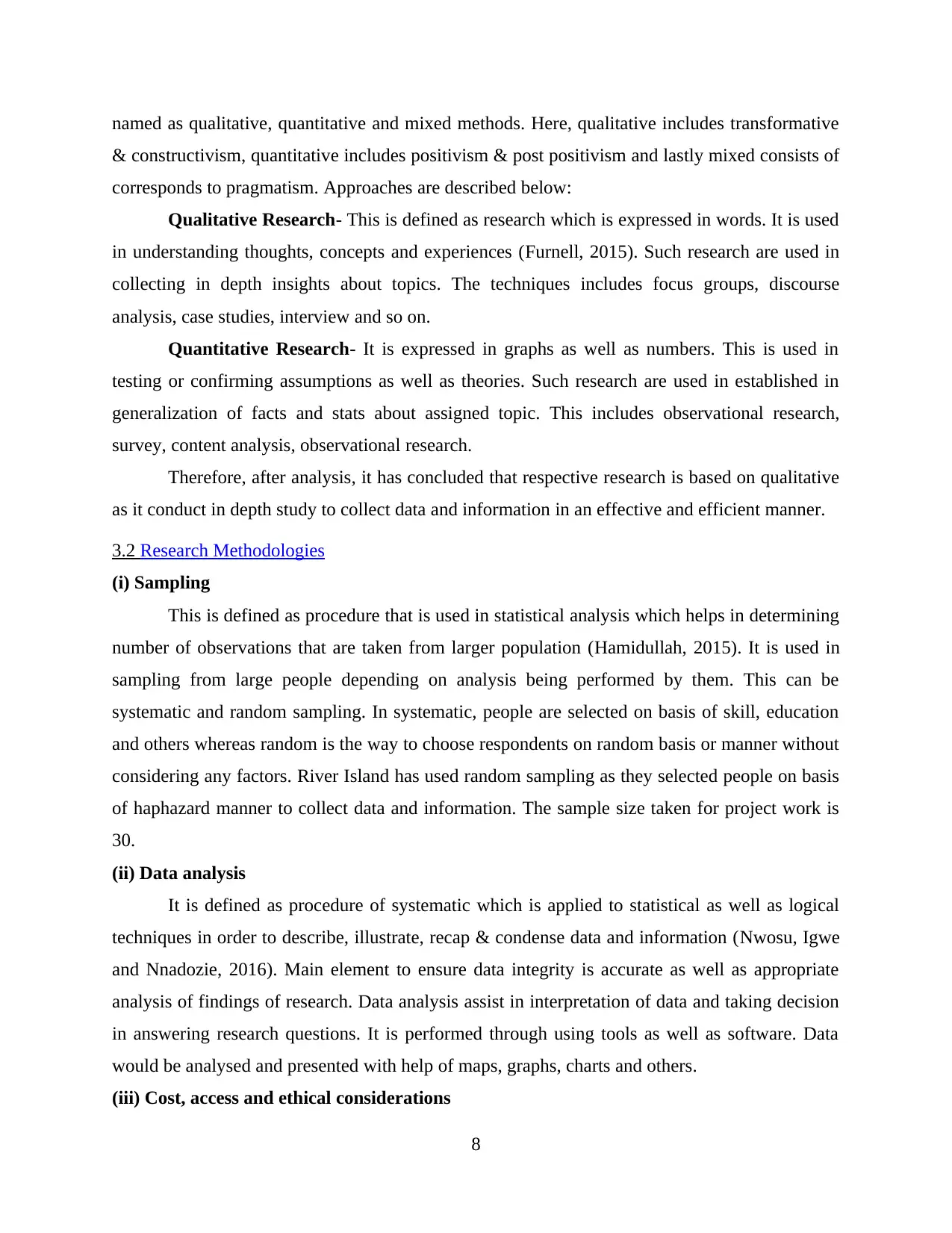
named as qualitative, quantitative and mixed methods. Here, qualitative includes transformative
& constructivism, quantitative includes positivism & post positivism and lastly mixed consists of
corresponds to pragmatism. Approaches are described below:
Qualitative Research- This is defined as research which is expressed in words. It is used
in understanding thoughts, concepts and experiences (Furnell, 2015). Such research are used in
collecting in depth insights about topics. The techniques includes focus groups, discourse
analysis, case studies, interview and so on.
Quantitative Research- It is expressed in graphs as well as numbers. This is used in
testing or confirming assumptions as well as theories. Such research are used in established in
generalization of facts and stats about assigned topic. This includes observational research,
survey, content analysis, observational research.
Therefore, after analysis, it has concluded that respective research is based on qualitative
as it conduct in depth study to collect data and information in an effective and efficient manner.
3.2 Research Methodologies
(i) Sampling
This is defined as procedure that is used in statistical analysis which helps in determining
number of observations that are taken from larger population (Hamidullah, 2015). It is used in
sampling from large people depending on analysis being performed by them. This can be
systematic and random sampling. In systematic, people are selected on basis of skill, education
and others whereas random is the way to choose respondents on random basis or manner without
considering any factors. River Island has used random sampling as they selected people on basis
of haphazard manner to collect data and information. The sample size taken for project work is
30.
(ii) Data analysis
It is defined as procedure of systematic which is applied to statistical as well as logical
techniques in order to describe, illustrate, recap & condense data and information (Nwosu, Igwe
and Nnadozie, 2016). Main element to ensure data integrity is accurate as well as appropriate
analysis of findings of research. Data analysis assist in interpretation of data and taking decision
in answering research questions. It is performed through using tools as well as software. Data
would be analysed and presented with help of maps, graphs, charts and others.
(iii) Cost, access and ethical considerations
8
& constructivism, quantitative includes positivism & post positivism and lastly mixed consists of
corresponds to pragmatism. Approaches are described below:
Qualitative Research- This is defined as research which is expressed in words. It is used
in understanding thoughts, concepts and experiences (Furnell, 2015). Such research are used in
collecting in depth insights about topics. The techniques includes focus groups, discourse
analysis, case studies, interview and so on.
Quantitative Research- It is expressed in graphs as well as numbers. This is used in
testing or confirming assumptions as well as theories. Such research are used in established in
generalization of facts and stats about assigned topic. This includes observational research,
survey, content analysis, observational research.
Therefore, after analysis, it has concluded that respective research is based on qualitative
as it conduct in depth study to collect data and information in an effective and efficient manner.
3.2 Research Methodologies
(i) Sampling
This is defined as procedure that is used in statistical analysis which helps in determining
number of observations that are taken from larger population (Hamidullah, 2015). It is used in
sampling from large people depending on analysis being performed by them. This can be
systematic and random sampling. In systematic, people are selected on basis of skill, education
and others whereas random is the way to choose respondents on random basis or manner without
considering any factors. River Island has used random sampling as they selected people on basis
of haphazard manner to collect data and information. The sample size taken for project work is
30.
(ii) Data analysis
It is defined as procedure of systematic which is applied to statistical as well as logical
techniques in order to describe, illustrate, recap & condense data and information (Nwosu, Igwe
and Nnadozie, 2016). Main element to ensure data integrity is accurate as well as appropriate
analysis of findings of research. Data analysis assist in interpretation of data and taking decision
in answering research questions. It is performed through using tools as well as software. Data
would be analysed and presented with help of maps, graphs, charts and others.
(iii) Cost, access and ethical considerations
8

It is very important for researcher to analyse cost, access and ethical consideration while
conducting research work in most appropriate manner (Pandey, 2019). In case of cost, they have
to prepare budget for each and every activities and operations which are going to be carried out.
On other hand, for access, information as well as data should be collected from authenticated
sources, online way, google scholars and so on. Ethical consideration is defined as particular part
of research. The ethical things which should be considered by researcher are validity, voluntary
participant & consent, sampling, confidentiality, risk of harm, research methods.
Chapter 4: Data Collection and Analysis for research
4.1 Research Data collection
Data collection is referred as procedure to gather as well as measure data and information
on different variables of interest in proper system which enables people to answer stated
questions of research, testing hypothesis and evaluation of outcomes (Laffy and Walters, 2016).
It is important for researcher to use appropriate method to collect data and information in
effective manner. This includes following:
Primary Data Collection- This is defined as collection of data by researcher from first
time source includes surveys, experiments, interview, questionnaire and so on (LaPorte and
Wright, 2016). It is time taking as well as expensive method because each and every information
is collected for first time.
Secondary Data Collection- It is defined as collection of data from second hand
information (Schwendicke and et. al., 2015). Such data are already provided or collected by one
person for some purpose and available for present issues. These are not pure or original source of
data collection. This includes publication of government, public records, reports of banks,
business, trade journals, technical, statistical documents and so on.
Therefore, from above it has concluded that respective organisation has adopted primary
method by preparing questionnaire in order to collect data and information in effective manner.
This provide accurate information about assigned topic to gather data as well as information.
Questionnaire
Q1. Are you familiarize with the concept of generation gap at workplace?
a. Yes
b. No
9
conducting research work in most appropriate manner (Pandey, 2019). In case of cost, they have
to prepare budget for each and every activities and operations which are going to be carried out.
On other hand, for access, information as well as data should be collected from authenticated
sources, online way, google scholars and so on. Ethical consideration is defined as particular part
of research. The ethical things which should be considered by researcher are validity, voluntary
participant & consent, sampling, confidentiality, risk of harm, research methods.
Chapter 4: Data Collection and Analysis for research
4.1 Research Data collection
Data collection is referred as procedure to gather as well as measure data and information
on different variables of interest in proper system which enables people to answer stated
questions of research, testing hypothesis and evaluation of outcomes (Laffy and Walters, 2016).
It is important for researcher to use appropriate method to collect data and information in
effective manner. This includes following:
Primary Data Collection- This is defined as collection of data by researcher from first
time source includes surveys, experiments, interview, questionnaire and so on (LaPorte and
Wright, 2016). It is time taking as well as expensive method because each and every information
is collected for first time.
Secondary Data Collection- It is defined as collection of data from second hand
information (Schwendicke and et. al., 2015). Such data are already provided or collected by one
person for some purpose and available for present issues. These are not pure or original source of
data collection. This includes publication of government, public records, reports of banks,
business, trade journals, technical, statistical documents and so on.
Therefore, from above it has concluded that respective organisation has adopted primary
method by preparing questionnaire in order to collect data and information in effective manner.
This provide accurate information about assigned topic to gather data as well as information.
Questionnaire
Q1. Are you familiarize with the concept of generation gap at workplace?
a. Yes
b. No
9
⊘ This is a preview!⊘
Do you want full access?
Subscribe today to unlock all pages.

Trusted by 1+ million students worldwide
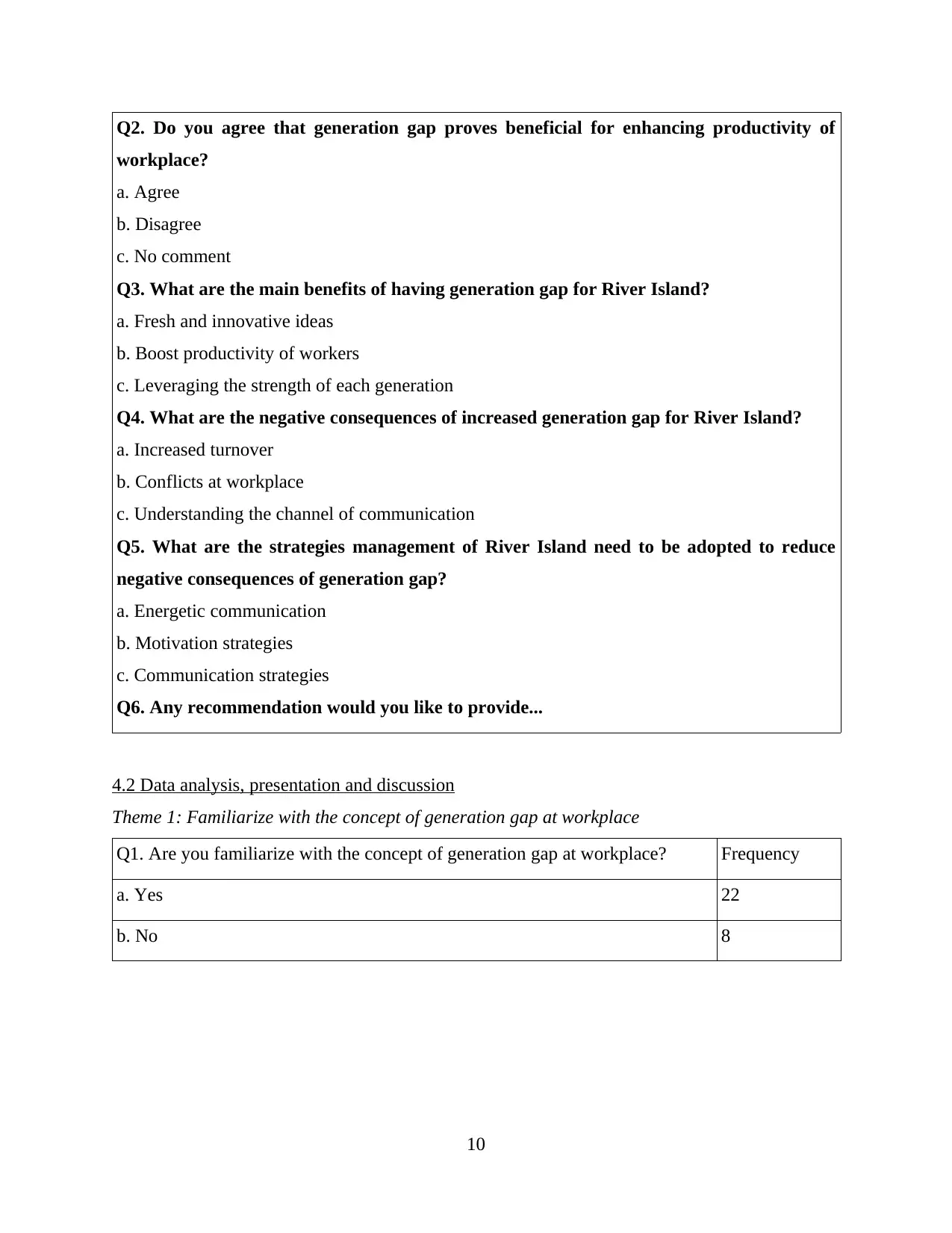
Q2. Do you agree that generation gap proves beneficial for enhancing productivity of
workplace?
a. Agree
b. Disagree
c. No comment
Q3. What are the main benefits of having generation gap for River Island?
a. Fresh and innovative ideas
b. Boost productivity of workers
c. Leveraging the strength of each generation
Q4. What are the negative consequences of increased generation gap for River Island?
a. Increased turnover
b. Conflicts at workplace
c. Understanding the channel of communication
Q5. What are the strategies management of River Island need to be adopted to reduce
negative consequences of generation gap?
a. Energetic communication
b. Motivation strategies
c. Communication strategies
Q6. Any recommendation would you like to provide...
4.2 Data analysis, presentation and discussion
Theme 1: Familiarize with the concept of generation gap at workplace
Q1. Are you familiarize with the concept of generation gap at workplace? Frequency
a. Yes 22
b. No 8
10
workplace?
a. Agree
b. Disagree
c. No comment
Q3. What are the main benefits of having generation gap for River Island?
a. Fresh and innovative ideas
b. Boost productivity of workers
c. Leveraging the strength of each generation
Q4. What are the negative consequences of increased generation gap for River Island?
a. Increased turnover
b. Conflicts at workplace
c. Understanding the channel of communication
Q5. What are the strategies management of River Island need to be adopted to reduce
negative consequences of generation gap?
a. Energetic communication
b. Motivation strategies
c. Communication strategies
Q6. Any recommendation would you like to provide...
4.2 Data analysis, presentation and discussion
Theme 1: Familiarize with the concept of generation gap at workplace
Q1. Are you familiarize with the concept of generation gap at workplace? Frequency
a. Yes 22
b. No 8
10
Paraphrase This Document
Need a fresh take? Get an instant paraphrase of this document with our AI Paraphraser
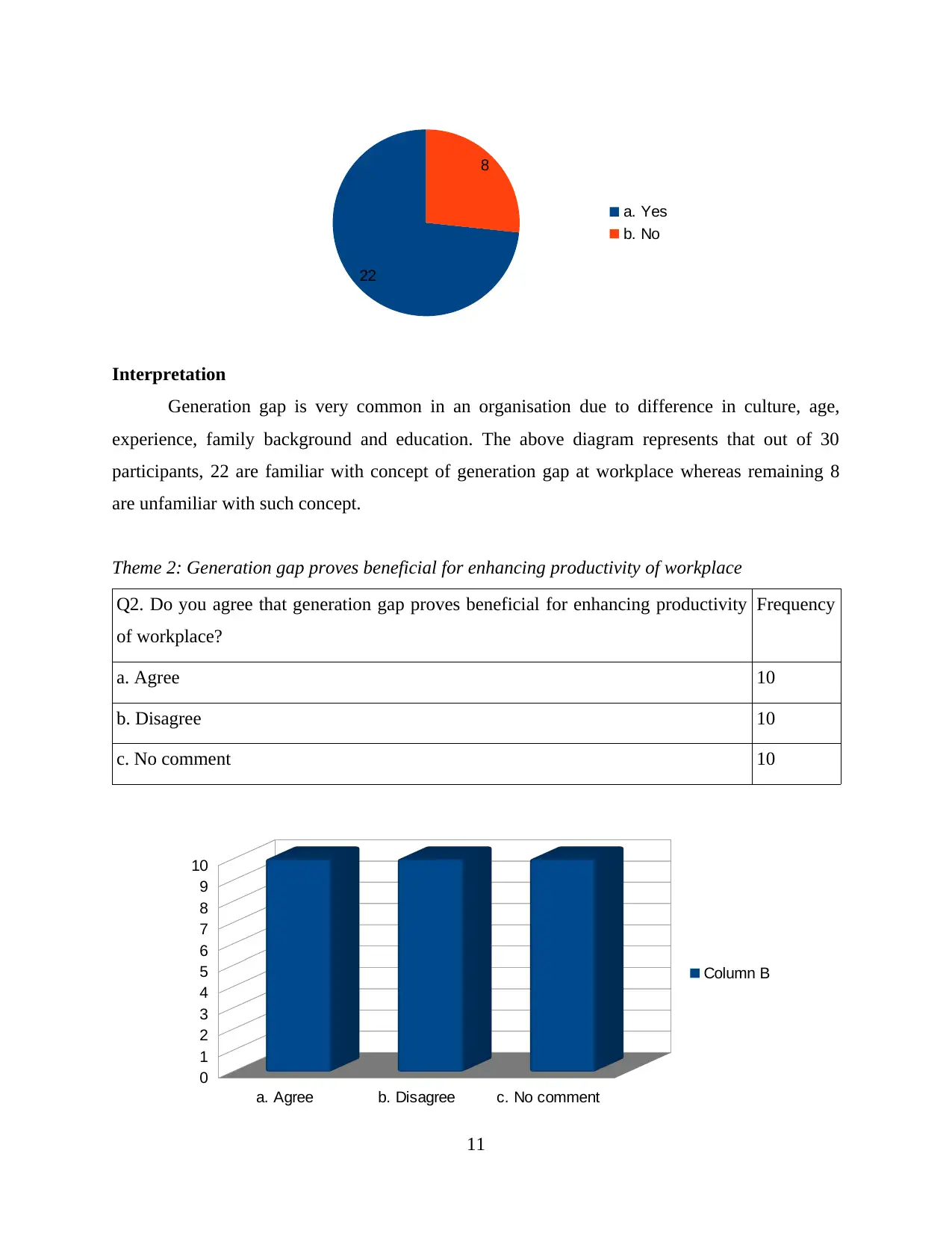
Interpretation
Generation gap is very common in an organisation due to difference in culture, age,
experience, family background and education. The above diagram represents that out of 30
participants, 22 are familiar with concept of generation gap at workplace whereas remaining 8
are unfamiliar with such concept.
Theme 2: Generation gap proves beneficial for enhancing productivity of workplace
Q2. Do you agree that generation gap proves beneficial for enhancing productivity
of workplace?
Frequency
a. Agree 10
b. Disagree 10
c. No comment 10
11
22
8
a. Yes
b. No
a. Agree b. Disagree c. No comment
0
1
2
3
4
5
6
7
8
9
10
Column B
Generation gap is very common in an organisation due to difference in culture, age,
experience, family background and education. The above diagram represents that out of 30
participants, 22 are familiar with concept of generation gap at workplace whereas remaining 8
are unfamiliar with such concept.
Theme 2: Generation gap proves beneficial for enhancing productivity of workplace
Q2. Do you agree that generation gap proves beneficial for enhancing productivity
of workplace?
Frequency
a. Agree 10
b. Disagree 10
c. No comment 10
11
22
8
a. Yes
b. No
a. Agree b. Disagree c. No comment
0
1
2
3
4
5
6
7
8
9
10
Column B
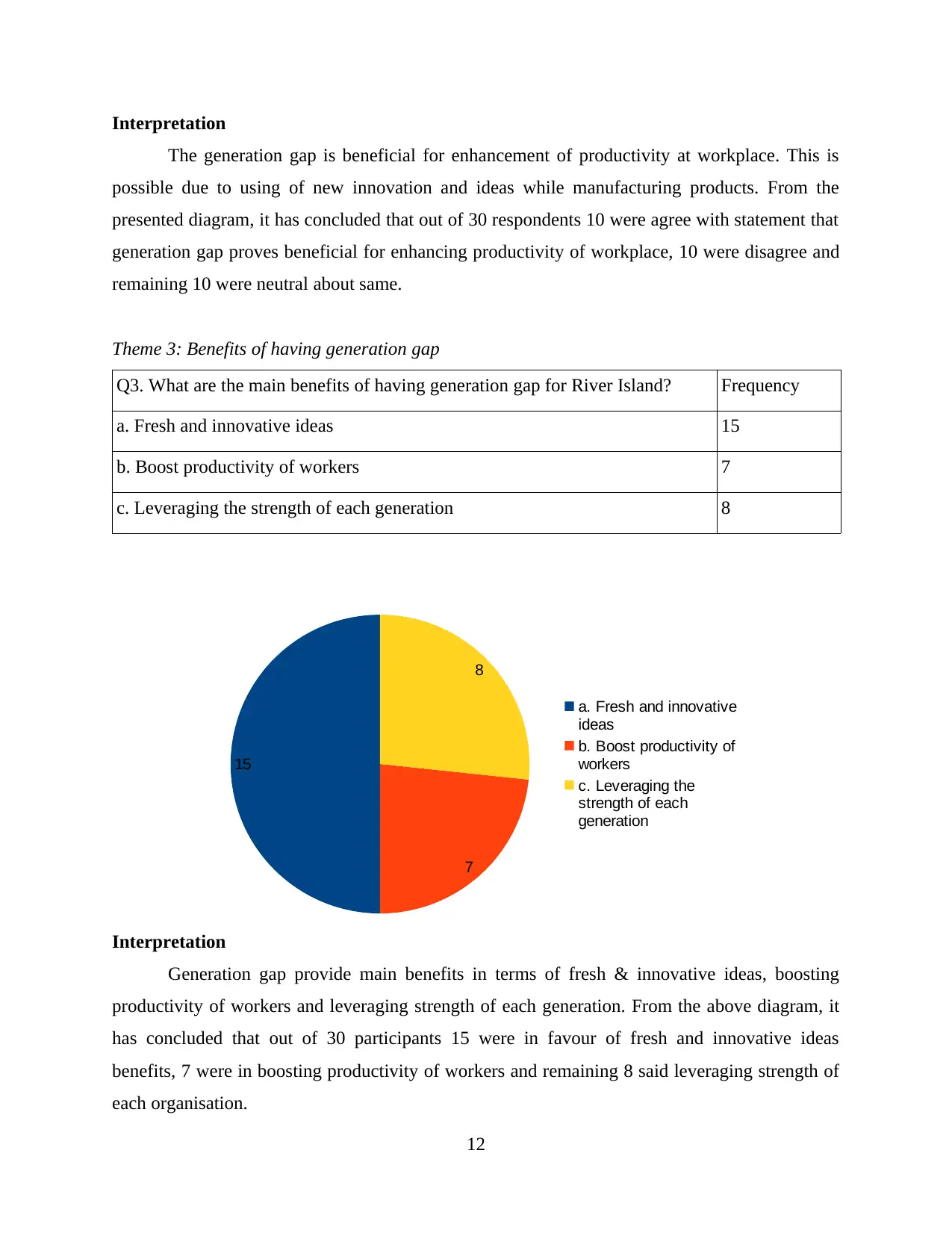
Interpretation
The generation gap is beneficial for enhancement of productivity at workplace. This is
possible due to using of new innovation and ideas while manufacturing products. From the
presented diagram, it has concluded that out of 30 respondents 10 were agree with statement that
generation gap proves beneficial for enhancing productivity of workplace, 10 were disagree and
remaining 10 were neutral about same.
Theme 3: Benefits of having generation gap
Q3. What are the main benefits of having generation gap for River Island? Frequency
a. Fresh and innovative ideas 15
b. Boost productivity of workers 7
c. Leveraging the strength of each generation 8
Interpretation
Generation gap provide main benefits in terms of fresh & innovative ideas, boosting
productivity of workers and leveraging strength of each generation. From the above diagram, it
has concluded that out of 30 participants 15 were in favour of fresh and innovative ideas
benefits, 7 were in boosting productivity of workers and remaining 8 said leveraging strength of
each organisation.
12
15
7
8
a. Fresh and innovative
ideas
b. Boost productivity of
workers
c. Leveraging the
strength of each
generation
The generation gap is beneficial for enhancement of productivity at workplace. This is
possible due to using of new innovation and ideas while manufacturing products. From the
presented diagram, it has concluded that out of 30 respondents 10 were agree with statement that
generation gap proves beneficial for enhancing productivity of workplace, 10 were disagree and
remaining 10 were neutral about same.
Theme 3: Benefits of having generation gap
Q3. What are the main benefits of having generation gap for River Island? Frequency
a. Fresh and innovative ideas 15
b. Boost productivity of workers 7
c. Leveraging the strength of each generation 8
Interpretation
Generation gap provide main benefits in terms of fresh & innovative ideas, boosting
productivity of workers and leveraging strength of each generation. From the above diagram, it
has concluded that out of 30 participants 15 were in favour of fresh and innovative ideas
benefits, 7 were in boosting productivity of workers and remaining 8 said leveraging strength of
each organisation.
12
15
7
8
a. Fresh and innovative
ideas
b. Boost productivity of
workers
c. Leveraging the
strength of each
generation
⊘ This is a preview!⊘
Do you want full access?
Subscribe today to unlock all pages.

Trusted by 1+ million students worldwide
1 out of 24
Related Documents
Your All-in-One AI-Powered Toolkit for Academic Success.
+13062052269
info@desklib.com
Available 24*7 on WhatsApp / Email
![[object Object]](/_next/static/media/star-bottom.7253800d.svg)
Unlock your academic potential
Copyright © 2020–2025 A2Z Services. All Rights Reserved. Developed and managed by ZUCOL.




